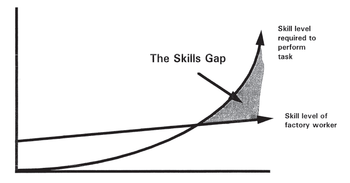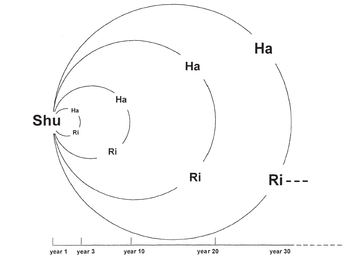ShuHaRi developing leaders who can be teachers
Add bookmark
Frequent and sudden recessive business cycles are posing major challenges to business leaders today. With the world going towards high levels of digitized technology, we are slowly losing our thinking capabilities and becoming slaves of this new digital fantasy. Therefore, in the real world, this is constantly creating an exponentially increasing skill gap.
With rapid changes in technology and product life cycles becoming shorter and shorter innovation and quick execution have become a necessity. To achieve this, knowledge, skills and behavior of people in the organization need to be synchronized with the organization’s growth. New learning also requires us to unlearn many of the old tools, techniques and methods. Thus the Shu-Ha-Ri Japanese learning system could provide a possible answer to this challenge. Let’s understand the system first.
The Shu-Ha-Ri System
To master a task, and to excel in it, we have to go through a focused learning curve. This is very similar to the lifecycle of a butterfly or any other species. A butterfly goes through 3 stages before it emerges finally as the brightly colored winged insect; there are no short cuts at any of the stages. Similarly, ShuHaRi is a structured Japanese technique to continue the journey of learning from student to master throughout one’s life. The length of the learning clearly depends on the type of task to be mastered. The ShuHaRi technique originated from the martial arts, which defines two aspects to any human learning to apply it to different work situations.
First, the body must be physically conditioned to the task; it must be able to work rhythmically to continuously be able to repeat tasks endlessly with the same efficiency to achieve the desired productivity and accuracy.
Second, the mind must be able to continuously concentrate and focus to transmit effective signals to produce the body rhythm.
We must understand that this is not a linear system but is a system of concentric circles as shown in the figure below.
Figure 2: The ShuHaRi System*
Sounds very obvious and simple, doesn’t it? So let’s examine in more detail how this system works and what its implications are.
Shu – to develop "Kata" by conditioning of body and mind to the task
In the Shu stage, the student does exactly as the Sensei (teacher) says. The student endlessly practices to copy the Sensei's examples. The student does not question "Why" and has no doubt about the Sensei’s knowledge and skills. When the Sensei decides the student is ready, he can move to the Ha stage.
Technically, the characteristic of this stage is learning and demonstration of the fundamentals through exactly replicating the master. This is done without the stress or burden of will, opinion, or judgment, but with a total openness and modesty. It is an important basic conditioning period both physically and mentally, wherein all the necessary conditions are carefully prepared for the next stage. The body parts are physically trained to synchronize with each other to rhythmically produce an outcome consistently, precisely and without fatigue.
The mind learns how to focus and concentrate attention on any particular part of the body at any given time. Thus, the mind develops to generate internal energy and natural flow through creativity.
Furthermore, one learns faith, trust, respect, endurance, modesty, sacrifice, and courage, all of which are required to apply knowledge and skills relative to the situation. The learning period in this stage depends on the strength, quality, ability and capability of the Sensei and student. The objective of Shu, is that a sound technical foundation can be built most efficiently by following only a single route to learning. The knowledge and skills are fully internalized; you do not need to think about it anymore; the student automatically does as has been taught.
The Shu learning strategy develops a defense against external negative influences, recognizing danger and avoiding mistakes. Thus the student develops a behavior pattern or "Kata".
Ha – Realization to reflect the purpose and improve one’s own task
In the Ha stage the student can question the skills he has learned. Why is it we do it as we do? Can we find a better way to do what we are doing?
Ha, is to break away or detach from tradition. In Ha, the student must reflect on the meaning and purpose of everything that he has learnt and thus, come to a deeper understanding of the task. At this stage, since each technique is thoroughly learned and absorbed, the student starts to question and reason about the background behind these techniques. In academic learning, the Ha stage can be likened to doing research work.
Actually, this is the stage wherein the student consolidates his learning to rearrange and reconstruct what the teacher has taught. This includes the elimination of wasteful activities, unnecessary or unsuitable and allows new methods and techniques to be brought into the study to increase efficiency and effectiveness. These changes are based on the true recognition of self together with surrounding conditions.
This is the stage, spiritually or mentally, when it is necessary to have a highly inquisitive mind and continuously do self-reflection (Hansei) to improve. During the Ha stage, the student must, through self-reflection, understand his/ her strengths and weaknesses thoroughly. Thus the student is required to attain a true and unshakable understanding of oneself as an individual. It is necessary to have a clear vision of one’s own potential and to stimulate it effectively. This might even require abandoning some of his/ her strengths. We must understand that gaining does not always necessarily mean always being creative; however it often means having to unlearn some things which are one’s strengths and this plays an important part in the Ha process. This is the most difficult part and one often is not convinced of its necessity due to lack of true insight and courage. Further, this pushes a person out of his/ her comfort zone.
Our human nature is such that it is actually difficult to shed some of our strengths. What the butterfly does in the caterpillar stage is very different from when it is butterfly. This is where most people get stuck and cease to grow. It is a matter of insight and perception in relation to the true recognition of self and our vision.
In this stage, both the Sensei (one who gives) and student (one who receives) contribute towards the birth of self-reliance. It is very similar to the formation of the butterfly from the chrysalis. If the time is not mature the butterfly may either die or become disabled. Once the butterfly has been created, it can move to the Ri stage.
Ri – To applying knowledge and skills to innovate and coach people
Ri, means to transcend. This can be compared to the butterfly which is now fluttering between various plants in the cross-pollination process. In this stage, one goes beyond all possible barriers and enters the world of innovation. He or she is more of an expert and surpasses his master. The student starts to think originally and starts to develop by applying his background skills and knowledge. He then starts to apply his new thoughts and tests them against the real situations of everyday life. In the Ri stage he becomes the creator of his own task or product and starts to own it. This is the completion of one’s study although not the end. Spiritually and mentally he becomes self-reliant and starts to coach and mentor other people.
This system can not only be used to train operators but also can be used for other tasks as well. This system still carries profound value for today's society, as it presents deep insight into the growth of human thinking. Furthermore, it clarifies the responsibilities of the teacher and student, thus contributing to the establishment of an ideal relationship between the two to contribute to the organization and ultimately to the society as a whole.
[eventPDF]
*Images sourced from: Zen Learning: A new approach to creating multi-skilled workers Dori Digenti MIT-JP 96-29






















